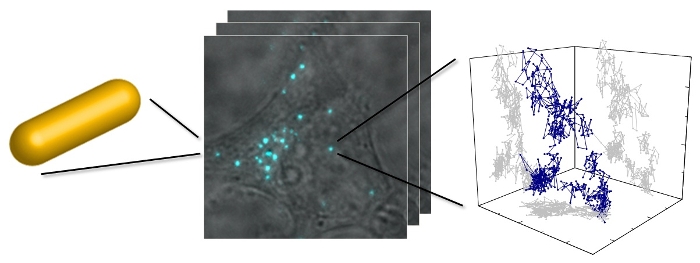Research project
Single gold nanorods in live cells
Visualization of biomolecules in living cells by tagging with gold nanoparticles.

With GFP-labeled proteins it is possible to image individual molecules inside living cells and study their dynamic behavior. However, due to the limited stability of the fluorescence of these proteins they can only be followed for about half a second. A solution to this problem is labeling proteins with tiny gold particles of approximately 40 nm in length, so-called gold nanorods. These rods can emit very bright optical signals that do not blink or bleach and are stable for long periods of time. This way, it will be possible to locate individual proteins inside a cell with very high (~10 nm) accuracy, and follow them for hours, enabling the study of a wide array of dynamic cellular processes at the single-molecule level. In addition to the imaging of gold nanorods inside cells, it is also possible to ‘trap’ these particles using focused laser light. With this technique local forces and torques that proteins experience inside cells can be measured.
The gold nanorods will be synthesized in the group of Dr. Alexander Kros (LIC), where they will be functionalized in such a way that they can be tagged to specifically labeled proteins in living cells. Imaging and tracking will be performed in the group of Dr. John van Noort (LION) using a specialized two-photon-luminescence setup. The trapping and further characterization of the gold nanorods will be done in the laboratory of Prof. Dr. Michel Orrit (LION).
Within the IBL, the PhD student Veer Keizer, supervised by Dr. Marcel Schaaf, will apply the developed technology to image and track individual glucocorticoid receptors. These receptors mediate the effects of the stress hormone cortisol and synthetic analogs of this hormone like prednisone and dexamethasone which are widely used as anti-inflammatory drugs. They act as transcription factors, which means that they bind to specific target sequences in the genome and thereby regulate transcription of a nearby gene. Using the gold nanorod technology it will be studied how glucocorticoid receptors find their target sequence, how (long) it binds to this sequence and what happens to a receptor after this binding event.


 FOM (Foundation for Fundamental Research on Matter)
FOM (Foundation for Fundamental Research on Matter)
 NWO
NWO